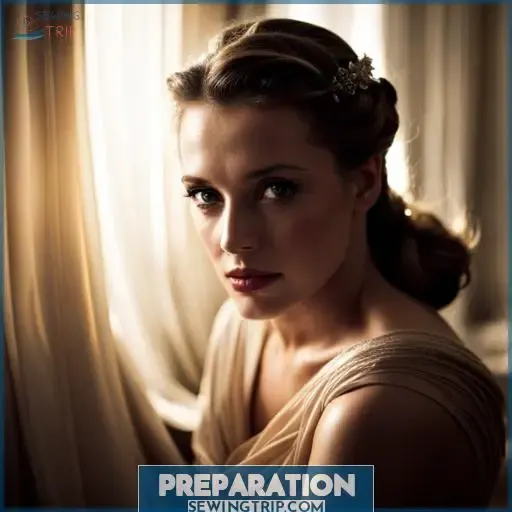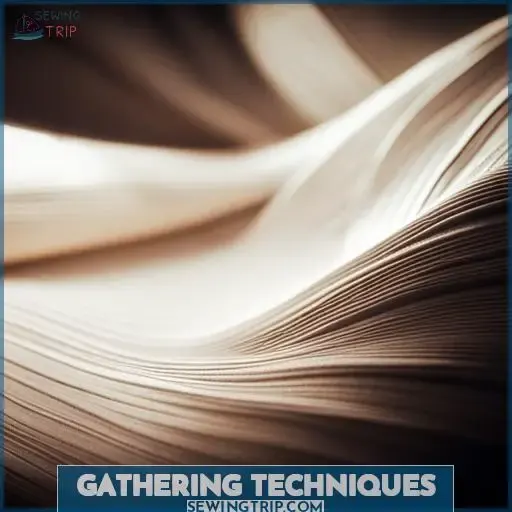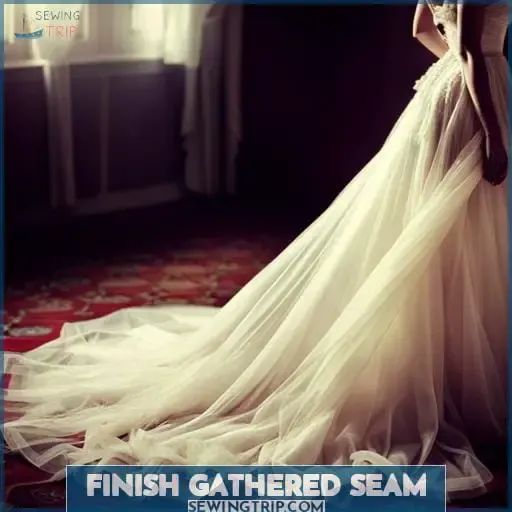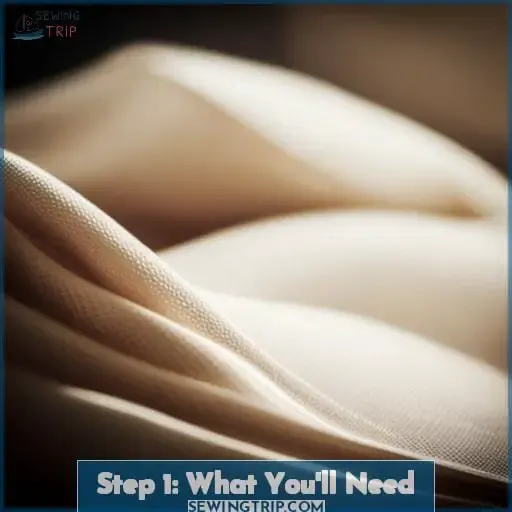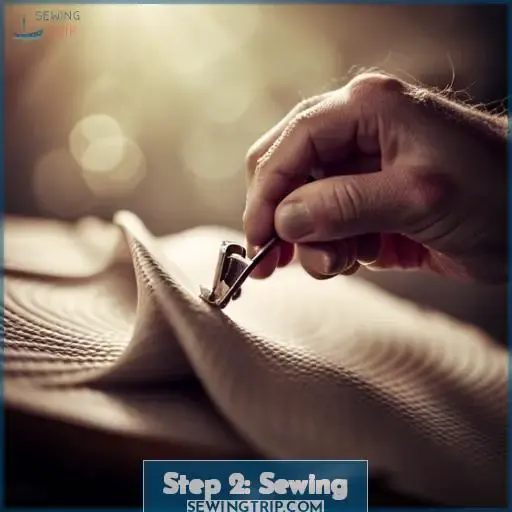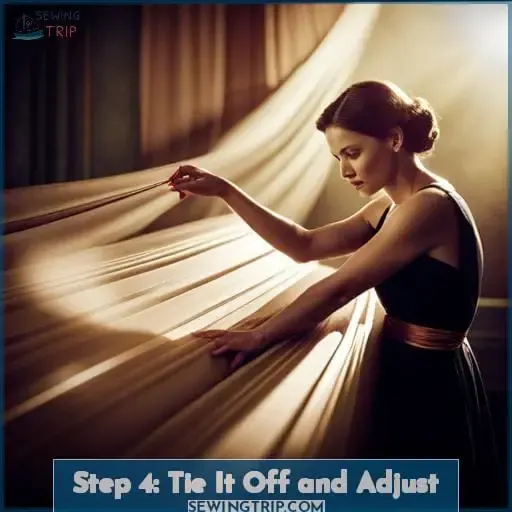This site is supported by our readers. We may earn a commission, at no cost to you, if you purchase through links.
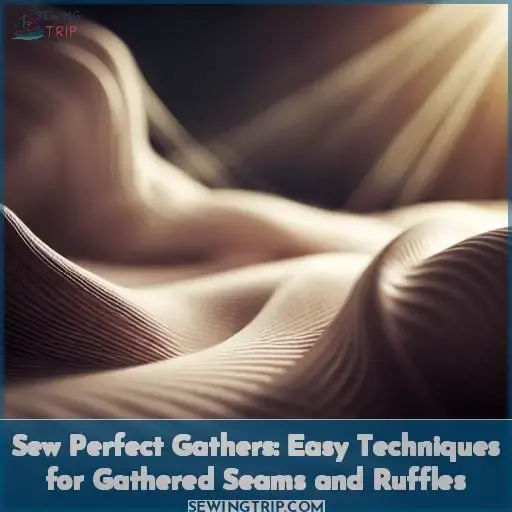
You there, dreaming of gathered skirts and ruffled blouses? Sewing gathers doesn’t have to be intimidating.
We’ll walk through easy techniques like two-thread gathering and zigzag over cord so you can create voluminous seams and romantic ruffles.
With some scrap fabric and the right settings, you’ll be gathering in no time.
Let’s make something beautiful!
Table Of Contents
Key Takeaways
- Basting stitches are used to create gathers by sewing two or more lines and then pulling the threads to gather the fabric.
- Gathers should be secured at both ends with pins, basting stitches, or knots before sewing to prevent slipping.
- Gathers are created on one piece of fabric that is then pinned to a flat piece with right sides together.
- It’s important to remove all gathering stitches once the final seam is sewn.
PREPARATION
How should you prepare before gathering fabric?
Before you start gathering, it’s crucial to prepare your materials and workspace.
Read up on different gathering techniques so you’re familiar with the options.
Test out stitch lengths, threads, and tensions on scrap pieces of your fabric first.
Make any adjustments needed for optimal gathering.
Once you’ve determined the best settings, carefully cut and mark any final pattern pieces, being sure to indicate the gathering areas on both the gathered piece and attaching piece.
Mark notches and balance marks as needed for alignment later.
Consider finishing any raw edges on delicate fabrics to prevent unraveling during the gathering process.
Proper preparation will set you up for sewing smooth, even gathers that beautifully shape your fabric.
GATHERING TECHNIQUES
Let’s move on to the different techniques you can use for creating gathers:
- Two thread gathering
- Three thread basting
- Zig zagging over a cord
Each has its own advantages, so test them out to see which you prefer.
With practice, you’ll get the hang of sewing perfect gathers every time.
Two Thread Gathering
You can create two thread gathers by sewing two lines of basting stitches 1/4 inch apart within the seam allowance or on either side of the stitch line seam allowance.
Use high-quality thread for durability.
Consider using a heavier thread if gathering heavier weight fabrics.
Adjust thread tension to make pulling thread easier.
Secure both ends with a pin, basting stitch, or knot to prevent losing gathers.
With patience and practice, you’ll gain confidence and mastery in these essential two thread gathering techniques for ruffles and supple gathers.
Three Thread Basting
You’re using a more secure technique if you sew one basting line at the final seam line and two basting lines within seam allowance or one basting line outside the final seam line and two basting lines within seam allowance.
With three-thread basting, you have multiple lines of stitching to hold the gathers in place before sewing the final seam.
Adjust thread tension so the threads pull smoothly. Knot the threads securely at both ends.
If gathering seems uneven, gently adjust the gathers for an even distribution along the fabric strip.
Zig Zag Over a Cord
Its versatility lets you gather delicate fabrics by zigzagging over a cord within the seam allowance.
Simply run a sturdy piece of yarn or cord the length of the gathered area, then sew over it using a wide zigzag stitch to gently gather the fabric.
Secure one end by wrapping the cord in a figure 8 around a pin.
Adjust zigzag width and length for different gather effects.
Test on scraps first when gathering loosely woven or stretchy fabrics.
SECURING GATHERS
How do you then secure the gathers once created?
You can secure both ends with a pin, basting stitch, or knot.
To secure with a pin, insert a pin at the end of the gathered area and wrap the thread tails around the pin in a figure 8 pattern until secure.
To secure with a basting stitch, thread a hand sewing needle with the thread tails and tack in place with a few repeated stitches.
To secure with a knot, simply pull the bobbin threads through to the right side of the fabric and tie them together with the needle threads in a tight double knot. Knotting the threads helps prevent the gathers from coming undone while completing your project.
FINISH GATHERED SEAM
Next, you’ll pin your gathered piece to the flat piece with right sides together.
Line up notches and edges for accurate placement, gently distributing gathers evenly.
With the gathered side up, stitch the final seam along your marked stitching line using regular stitch length.
Remove all gathering stitches when done.
Gently press the seam away from the gathers, taking care not to flatten them.
Proper pressing technique here helps the seam lay flat and reduces bulk.
Check that thread tension is correctly balanced so the gathers don’t pull out.
For a clean finish, choose tightly woven fabrics and finish raw edges before gathering to prevent fraying.
If working with tricky fabrics like satin or jersey, use a specialty gathering foot for perfect gathers every time.
With good notch placement and edge finishing, you’ll achieve gorgeous gathered seams and ruffles.
Step 1: What You’ll Need
What You’ll Need:
- A piece of fabric to gather (flat strip, folded strip, hemmed strip, tube, or bias cut strip)
- Sewing machine
- Ruler (optional)
- Long stitch length set to 3-4
- Long thread tails (3-4 inches)
Consider:
- Thread weight and fabric weight
- Gathering variations (traditional straight stitch gathering, corded zigzag gathering, or using a specialty gathering foot)
- Adjust tension as needed based on your sewing machine model
Troubleshooting:
- Work in smaller increments to avoid jamming
Step 2: Sewing
To continue with the process of creating perfect gathers, you’ll now move on to the next step: sewing.
Carefully prepare your fabric by ensuring the edges are finished so they don’t fray.
Set up your sewing machine for the desired gathering technique by selecting a long stitch length of 3-4 and loosening the tension slightly.
Before sewing, mark guidelines on the fabric where you want the gathers to fall.
Sew either two rows of basting stitches 1/8” apart or zigzag over a piece of sturdy string or yarn, leaving 3-4” thread tails on both ends.
As you sew, allow the fabric to gently feed against the resistance of your finger, initiating light gathers.
If gathering jams, backstitch and work in smaller increments.
With the right prep and machine setup, you’ll achieve gorgeous gathers for ruffles, sleeves, yokes, and more.
Step 3: Gathering
Gathering:
Now, you start pulling the top threads with your right hand while gently tugging the fabric toward you with your left to gather it to the desired ruffle length. Distribute gathers evenly along the strip. If gathering seems to jam up, back off the threads slightly and work in smaller increments.
When preparing to gather, mark guidelines on the fabric first for evenly spaced gathers. For specialty machine feet that gather as you sew, follow specific instructions.
Finally, troubleshoot gathering issues by preparing fabric properly and checking tension settings. With these gathering techniques, you’ll achieve beautiful gathered seams and flawless ruffles.
Step 4: Tie It Off and Adjust
With your fabric gathered up nicely, it’s time to secure everything before sewing our final seam.
Simply tie the threads from both sides of the fabric together in a secure knot, followed by tying all four threads collectively.
Snip any excess, being careful not to accidentally cut the gather threads.
Now comes the fun part – shaping the gathers!
Fluff, twist, scrunch, or fan out the fabric as desired to create your perfect gather layout.
For very long pieces, work in smaller sections.
If things get too tight, gently pull the knots loose and ease up the gather slightly before retying.
Once our gathers are adjusted, we’ll sew our final seam right over the gathering stitches in the next step.
Frequently Asked Questions (FAQs)
How much fabric do I need for gathered pieces?
For gathered pieces, multiply the finished length by at least 5-2x to determine the cut length of fabric needed.
This allows enough fabric to elegantly gather and prevent pulling or straining the seam when distributing fullness.
Different widths may require more or less ease.
What kind of projects are best for using gathers?
Ruffles on skirts, sleeves, curtains, pillows, and children’s clothes allow whimsy.
Gather tiers in circle skirts and peasant blouses for fluidity.
Shirt yokes, necklines, waistlines beg sweetness of delicate gathers.
Choose them when you crave that feminine romance in your sewing.
How do I calculate how much to gather fabric when I know the finished size I need?
When embarking on your sewing journey, envision the finished garment,
draped elegantly, its gathers flowing like a gentle brook.
Calculate the fabric needed by dividing the finished size by the desired fullness.
Gather, my dear, gather, and watch your creation come to life.
What are some common mistakes to avoid when sewing gathers?
Pull threads evenly when gathering to prevent uneven puckering.
Check tension settings, as improper tension can cause frustrating thread breaks.
Be patient guiding longer pieces under the presser foot to prevent jamming.
Carefully align notches after gathering to keep edges matched up properly.
How do I make evenly spaced gathers?
Carefully measure and mark evenly spaced dots along the edge before sewing your gathering stitches.
Gently pull threads while distributing fullness between each mark.
Check spacing frequently and adjust as needed while gathering.
Conclusion
Listen up, seamstresses!
With a few spools and scrap fabric, you’ve unlocked the magical art of gathering.
Embrace the dreamy potential of billowing hems and textured trims, whether nodding to nostalgic ruffles or modern minimalism.
Simply follow our friendly techniques, from two-thread pulls to zigzagged cords, and discover the transformative joy of sewing gathers.
Now go on, make something beautiful!

